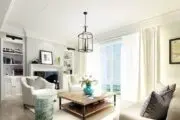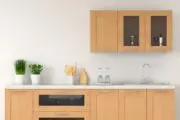The idea of being able to personalize and customize a new build is what draws many buyers, but when it comes time to begin the selection of finishes and upgrades at the design studio, the choices can seem overwhelming.
The best way to create a stylish home that you’ll love is to prepare for visits to the design studio ahead of time, armed with pre-selected inspiration, a list of priorities and an open mind to the possibilities.
Before the first visit to the design studio
Homeowners should contemplate life in their current home before planning their new one at the design studio, according to Lee Crowder, national director of design & model experience with Taylor Morrison.
“Take into account what you like and don’t like in your current home. Let real life experience help guide your decisions with the design experts,” she says.
This context will help homeowners to make function-first choices, which will be the most beneficial in the long run.
Prior to stepping foot in the design studio, homeowners should have established their budget for design upgrades, and already have an understanding of what is considered standard and what is a builder upgrade. Homeowners may have negotiated certain upgrades, or their home purchase may come with an upgrade allowance.
There are certain builder upgrades that are known to add more value. It’s also important to express your personal style with your décor choices. It’s all about striking a balance.
Build a wish list of upgrade priorities, keeping in mind that some upgrades can be done down the road DIY or by a contractor, especially if a homeowner is uncertain, or if there are budget constraints.
What should I expect at the design studio?
Most builders offer two to three visits to the design studio. Homeowners will likely already have had a chance to view options for finishes when they made their purchase with the sales consultant, but as the process moves along, homeowners get hands-on in the design studio, usually with the help of an in-house design consultant, although if homeowners are working with their own interior designer, they are usually welcome to attend appointments as well.
Homeowners will work through a room-by-room list of finishes, structural elements (such as windows and doors) and décor, both for inside and outside the home.
“After reviewing the floorplan and structural options, we then follow a workflow that focuses on the investment pieces that impact and set the tone for the entire home, including appliances, cabinets and countertops. Once these items are selected and customers have a better understanding of overall design, pricing and selections, we start layering in additional finish materials such as flooring, wall tile, plumbing, lighting, hardware and more,” says Crowder.
While builders vary in their approaches and available tools, the overarching goal is the same at the design center: to help homeowners articulate their design ideas, match available products to the selection checklist and offer options across different upgrade categories depending on homeowner choice and budget.
“Our choices are showcased in a series of stunning vignettes that buyers can walk through with their design consultant. They can see and touch all of their options, select their favorites, and get a true sense of how the details come together,” says Lisa McClelland, Toll Brothers senior vice president of design studios.
Design studios are meant to be immersive and tactile to help demonstrate how various colors and finishes interplay in a real home.
“We provide samples of most of the options we offer so customers can see and touch items such as tile, wood, paint, faucets and many other finishes and features. Our design studios have personal co-creation rooms so customers can openly ask questions and discuss options for their home,” says Sherri Drew, vice president of design studios with Tri Pointe Homes.
Finding inspiration
Prior to the first visit, spend time sifting through design and social media to decide what colors and styles are most appealing. And if the choices are too overwhelming, it is ok to start by eliminating what you don’t like.
Designers use mood boards to help contextualize design ideas, colors and materials so that homeowners can better visualize not just what initial design elements they are drawn to, but how selections relate to each other.
A mood board is kind of like a collage, with collected fabrics, colors, samples and photos to represent specific ideas. Homeowners will find creating their own mood board, either physically or digitally, a worthwhile exercise to help organize their thoughts and to articulate their preferences.

Also useful for inspiration are model homes, as they provide décor ideas that may be most relevant to homeowners. Seeing options in real-time can take some of the guesswork around how different finishes and colors might look on a larger scale.
Trust the design consultant
Most builders offer in-house advice, and buyers are smart to take advantage of the advice they are given during their appointments.
New build design consultants not only guide homeowners towards trends that match their style, but also help homeowners ask the proper lifestyle-based questions to create the right aesthetic.
“Consider your priorities and determine what is most important to you in terms of where you spend the most time in your home and your lifestyle goals,” says McClelland.
Homeowners shouldn’t be shy to communicate, as articulating their needs is the best way to create a home that they’ll love to live in, in addition to creating the desired aesthetic.
“Share how you plan to live in your home. We have products that perform differently for different lifestyles and want to suggest the best products for you for years to come,” says Drew.
Getting the most from design studio appointments
Want to make the most of the design studio appointments? Remove distractions from the task at hand.
- Leave enough time to properly view all the options available in the design center and have enough time between appointments to thoroughly weigh out selections.
- Take pictures of your selections and bring home samples whenever possible.
- It’s a good idea to eat before appointments, so decisions won’t be made hastily.
- Arrange for childcare and consider declining offers from friends and family with strong opinions who want to accompany you to appointments, especially if their style is contrary to your own
“By only bringing the decision makers, you’ll save time during your appointment and be completely confident in what you picked out,” says Crowder.







